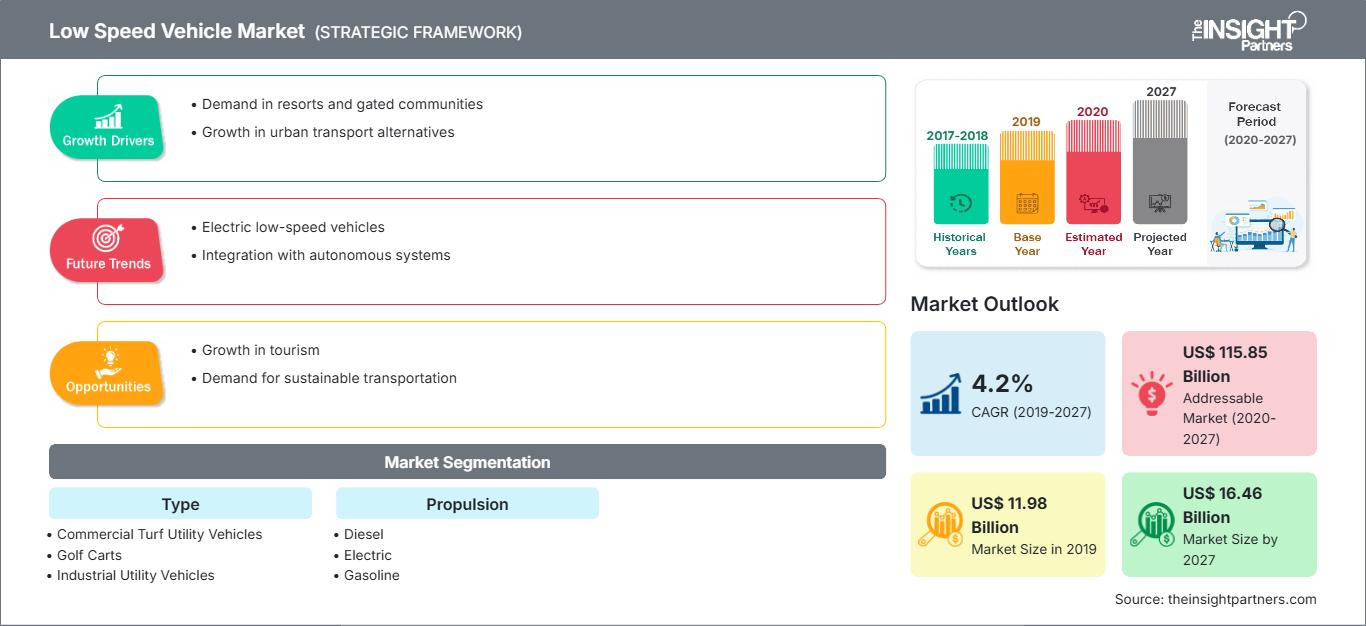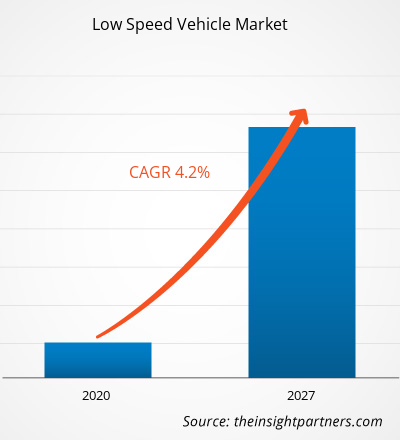저속차 시장은 2019년 119억 8천만 달러 규모였으며, 2020년부터 2027년까지 연평균 4.2% 성장하여 2027년에는 164억 6천만 달러에 이를 것으로 예상됩니다.
저속차 시장은 지난 몇 년간 전 세계적으로 눈에 띄는 성장을 보였습니다. 긍정적인 경제 전망, 가처분소득 증가, 그리고 인구 증가는 인프라 프로젝트 수요를 견인하는 요인 중 하나입니다. 또한, 온라인 주문량 증가와 관련하여 전자상거래 산업이 성장하고 있으며, 이는 해당 지역의 창고 소유 증가로 이어질 것입니다. 창고 내 저속차는 상자를 한 곳에서 다른 곳으로 옮기는 데 도움이 됩니다. 이러한 요인들은 저속차 시장 성장을 가속화하는 데 중요한 역할을 합니다. 아시아 태평양 지역은 2019년 가장 큰 시장 점유율을 기록했으며, 저속차 시장에서 가장 빠르게 성장하는 지역이 될 것으로 예상됩니다. 북미와 유럽은 저속차 시장에서 각각 두 번째와 세 번째로 큰 지역입니다.
코로나바이러스는 2019년 12월 중국 우한에서 시작되었습니다. 전 세계로 빠르게 확산되고 있으며, 중국, 이탈리아, 이란, 스페인, 한국, 프랑스, 독일, 미국 등 가장 큰 피해를 입은 국가들이 있습니다. COVID-19의 발생과 국경 봉쇄, 봉쇄, 여행 금지 등의 영향은 다양한 산업 분야의 기업에 영향을 미치기 시작했습니다. 저속 차량 시장은 글로벌 공급망의 차질로 인해 중간 정도의 영향을 미칠 것으로 예상됩니다. 이 시장에서 활동하는 기업들은 단기적으로(3~6개월) 전체 매출이 감소하겠지만, 향후 몇 년간 꾸준한 성장세를 보일 것으로 예상됩니다.
요구 사항에 맞게 이 보고서를 사용자 정의하십시오.
이 보고서의 일부, 국가 수준 분석, Excel 데이터 팩을 포함하여 모든 보고서에 대한 사용자 정의를 무료로 받을 수 있을 뿐만 아니라 스타트업 및 대학을 위한 훌륭한 제안 및 할인을 이용할 수 있습니다
저속 차량 시장: 전략적 통찰력

-
이 보고서의 주요 주요 시장 동향을 확인하세요.이 무료 샘플에는 시장 동향부터 추정 및 예측에 이르기까지 데이터 분석이 포함됩니다.
유럽 연합, 중국, 일본, 캐나다, 인도, 한국은 정부가 전기 자동차 도입 확대를 위해 적극적으로 조치를 취하고 있는 주요 지역입니다. 예를 들어, 유럽 연합에서는 기존 차량의 연비 기준이 크게 개선되었습니다. 정부 부문의 전기 버스 조달을 위한 '청정 차량 지침(Clean Vehicles Directive)'이 제정되었습니다. 또한 건물 내 충전 인프라 구축을 위한 최소 기준을 정하는 '에너지 성능 건물 지침(Energy Performance Buildings Directive)'도 제정되었습니다.
추진력 통찰력
저속 차량 시장은 추진 방식에 따라 디젤, 전기, 가솔린으로 구분됩니다. 연료 구동 부문은 세계 저속 차량 시장에서 지배적인 점유율을 차지했습니다. 허용 도로에서 주행할 수 있고 유틸리티 차량 및 인력 수송 차량으로 활용될 수 있는 고출력 차량의 수요가 증가하고 있습니다. 따라서 예측 기간 동안 전기 저속 차량은 고출력 저속 차량과 함께 상당한 성장을 보일 것으로 예상되며, 이는 결국 저속 차량 시장을 주도할 것으로 예상됩니다.
유형별 분석
저속 차량 시장은 유형별로 상업용 잔디밭 유틸리티 차량, 골프 카트, 산업용 유틸리티 차량, 그리고 개인용 운반차로 구분됩니다. 골프 카트 부문은 세계 저속 차량 시장에서 지배적인 점유율을 차지했습니다. 미국의 여러 지역 사회는 저속 전기 차량에 크게 의존하여 이동하고 있습니다. 노인의 경우 걷기가 어려울 수 있으며, 자동차를 운전하는 것은 부담스럽고 심지어 안전하지 않을 수 있습니다.
기업들은 전 세계적으로 사업 영역을 확장하고 증가하는 수요를 충족하기 위해 시장 주도권과 새로운 개발 전략을 일반적으로 채택합니다. 이러한 전략은 주로 북미와 유럽에서 관찰됩니다. 저속 차량 시장의 주요 기업들은 전 세계 고객 기반을 확대하기 위해 확장 및 연구 개발 투자 전략을 채택하고 있으며, 이를 통해 전 세계적으로 브랜드 인지도를 유지할 수 있습니다.
저속 차량 시장 지역별 통찰력
The Insight Partners의 분석가들은 예측 기간 동안 저속 차량 시장에 영향을 미치는 지역별 동향과 요인들을 면밀히 분석했습니다. 이 섹션에서는 북미, 유럽, 아시아 태평양, 중동 및 아프리카, 그리고 중남미 지역의 저속 차량 시장 부문 및 지역별 현황도 살펴봅니다.
저속 차량 시장 보고서 범위
| 보고서 속성 | 세부 |
|---|---|
| 시장 규모 2019 | US$ 11.98 Billion |
| 시장규모별 2027 | US$ 16.46 Billion |
| 글로벌 CAGR (2019 - 2027) | 4.2% |
| 이전 데이터 | 2017-2018 |
| 예측 기간 | 2020-2027 |
| 다루는 세그먼트 |
By 유형
|
| 포함된 지역 및 국가 |
북미
|
| 시장 선도 기업 및 주요 회사 프로필 |
|
저속 차량 시장 참여자 밀도: 비즈니스 역학에 미치는 영향 이해
저속 차량 시장은 소비자 선호도 변화, 기술 발전, 그리고 제품 이점에 대한 인식 제고 등의 요인으로 인한 최종 사용자 수요 증가에 힘입어 빠르게 성장하고 있습니다. 수요가 증가함에 따라 기업들은 제품 라인업을 확장하고, 소비자 니즈를 충족하기 위한 혁신을 추진하며, 새로운 트렌드를 적극 활용하고 있으며, 이는 시장 성장을 더욱 가속화하고 있습니다.

- 을 얻으세요 저속 차량 시장 주요 주요 플레이어 개요
- 상업용 잔디밭 유틸리티 차량
- 골프 카트
- 산업용 유틸리티 차량
- 인력 수송차
저속 차량 시장 - 추진력별
- 디젤
- 전기
- 가솔린
저속 차량 시장 - 지리별
-
북미
- 미국
- 캐나다
- 멕시코
-
유럽
- 프랑스
- 독일
- 이탈리아
- 영국
- 러시아
- 유럽의 나머지 지역
-
아시아 태평양
- 중국
- 인도
- 호주
- 한국
- 일본
- 아시아 태평양의 나머지 지역
-
중동 및 아프리카
- 남아프리카공화국
- 사우디아라비아
- UAE
- 중동 및 아프리카 기타 지역
-
남아메리카
- 브라질
- 아르헨티나
- 남아메리카 기타 지역
회사 프로필
- Bintelli Electric Vehicle
- Club Car, LLC
- Cruise Car, Inc.,
- Deere & Company
- HDK Co., Ltd.
- Moto Electric Vehicles
- Polaris Inc.
- Textron Specialized Vehicles Inc.
- The Toro Company
- Yamaha Golf-Car Company
- 과거 분석(2년), 기준 연도, CAGR을 포함한 예측(7년)
- PEST 및 SWOT 분석
- 시장 규모 가치/거래량 - 글로벌, 지역, 국가
- 산업 및 경쟁 환경
- Excel 데이터세트
최근 보고서
관련 보고서
사용 후기
구매 이유
- 정보에 기반한 의사 결정
- 시장 역학 이해
- 경쟁 분석
- 고객 인사이트
- 시장 예측
- 위험 완화
- 전략 기획
- 투자 타당성 분석
- 신흥 시장 파악
- 마케팅 전략 강화
- 운영 효율성 향상
- 규제 동향에 발맞춰 대응






















 무료 샘플 받기 - 저속 차량 시장
무료 샘플 받기 - 저속 차량 시장